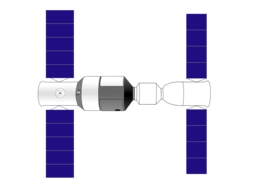 Diagram of Shenzhou 8 (right) docked with Tiangong-1 (left) | |
| Mission type | Test flight |
|---|---|
| COSPAR ID | 2011-063A |
| SATCAT no. | 37859 |
| Mission duration | 18 days |
| Spacecraft properties | |
| Spacecraft type | Shenzhou |
| Start of mission | |
| Launch date | 31 October 2011, 21:58:10.430 UTC |
| Rocket | Long March 2F |
| Launch site | Jiuquan, LA-4/SLS-1 |
| Contractor | China Academy of Launch Vehicle Technology (CALT) |
| End of mission | |
| Landing date | 17 November 2011, 11:32 UTC |
| Landing site | Siziwang Banner, Inner Mongolia |
| Orbital parameters | |
| Reference system | Geocentric orbit |
| Regime | Low Earth orbit |
| Inclination | 51.37° |
| Docking with Tiangong-1 | |
| Docking date | 2 November 2011, 17:28 UTC |
| Docking with Tiangong-1 | |
| Docking date | 14 November 2011, 12:07 UTC |
| Undocking date | 16 November 2011, 10:30 UTC |
| Time docked | 1 day, 22 hours, 23 minutes |
| Shenzhou 8 | |||||||||||||||||||||
|---|---|---|---|---|---|---|---|---|---|---|---|---|---|---|---|---|---|---|---|---|---|
| Chinese | 神舟八号 | ||||||||||||||||||||
| |||||||||||||||||||||
Shenzhou 8 (Chinese: 神舟八号) was an uncrewed flight of China's Shenzhou program,[1] launched on 31 October 2011 UTC, or 1 November 2011 in China, by a Long March 2F rocket which lifted off from the Jiuquan Satellite Launch Center.[2]
The Shenzhou 8 spacecraft was automatically docked with the Tiangong-1 space module (launched on 29 September 2011) on 3 November 2011 and again on 14 November 2011.[3] This uncrewed docking – China's first – was followed in 2012 with the crewed Shenzhou 9 mission, which performed a crewed docking (also China's first) with the Tiangong-1 module.[1][4] Only the Soviet Union (Russia), Japan[5] and the European Space Agency (ESA) had achieved automatic rendezvous and docking prior to China's accomplishment.
- ^ a b David, Leonard (7 March 2011). "China Details Ambitious Space Station Goals". Space.com. Retrieved 11 March 2011.
- ^ Cite error: The named reference
nsf20111031was invoked but never defined (see the help page). - ^ Wall, Mike (2 November 2011). "China Succeeds in First Space Docking by 2 Spaceships". Space.com. Retrieved 12 August 2021.
- ^ Clark, Stephen (12 May 2011). "Docking, extended space missions up next for China". Spaceflight Now. Retrieved 13 May 2011.
- ^ ETS-VII